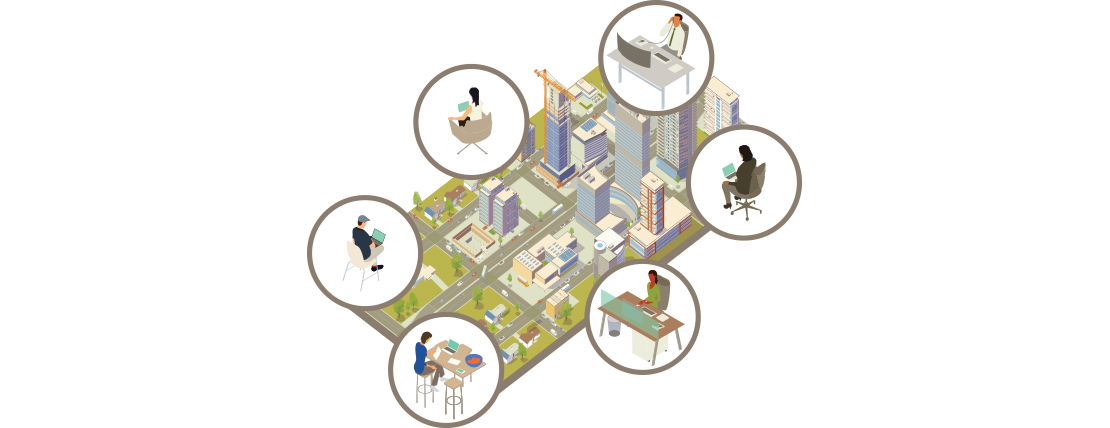When I wrote an article for WorldatWork in September 2020, I talked about leading employees through the monumental changes in their lives as they dealt with the pandemic. I didn’t think we’d still be discussing this same topic a year later, yet here we are. Although much has changed over the past year or so, I’m experiencing a strong sense of déjà vu.
I’m the leader of a legal insurance company headquartered in the Midwest, still facing many of the same challenges that you probably are, including the persistent presence of COVID-19, employee turnover and a “return to work” plan that continues to change, sometimes by the day.
It’s a complex world right now. People have been grappling with coaxing their kids through online learning, unexpected weather events, caring for elderly parents and more. The result? Employees’ morale is getting pulled in all directions as the lingering question, “Am I going in, am I staying home?” wears on them.
Managing this constant state of flux may feel like swimming in shark-infested waters, with no land in sight: some days you have to swim really fast, while others you’re just treading water. How do you navigate all that — all with an entire workforce in tow?
Redirecting The “Great Resignation”
By now, you’ve probably heard of “The Great Resignation.” Employees seemed to have tapped the brakes on their resignation during the pandemic, and then put in their two-week notice en masse. Others may have discovered that their current company or position left much to be desired and have moved on, some to different careers entirely.
For those who were going to leave before the pandemic put that plan on hold, it’s critical to communicate with them before they disengage. Team members who can’t see how what they’re doing is making a difference are more apt to go somewhere else. That’s why we spend so much time connecting team members to the company focus areas and business strategy, so they know their work has a direct correlation to growing the company.
Retaining these employees also involves being fair and flexible, adjusting as situations come up and ensuring there’s solid overall compensation in place, not just a laundry list of benefits. So, when you look at your corporate culture, it reinforces that successfully recruiting and retaining employees is a critical business strategy.
For the second group of at-risk employees, retention is more difficult. When the pandemic serves as sort of a wake-up call for some to embark on an entirely new opportunity, we’ll support their decision, congratulate them and wish them well.
A True Balancing Act
When it comes to how and where they work, a recent study shows that employees want the best of both worlds: more than 70% of workers want flexible remote work options to continue, while more than 65% are craving more in-person time with their teams. At ARAG, we found our employees similarly inclined. In an employee survey, the majority (75%) wanted to return to the office in some capacity, while others wanted to work only from home.
For me, this reaffirmed both how diverse everyone’s situation is, and the essential things to consider when returning to the office. For example, I realized that, while some people thrive when working from home, others may not have the ideal environment to work virtually.
We took all these disparate needs into account while also weighing our business goals. While we can’t please everyone, I’ve found if employees understand the “why” behind these decisions, it helps them buy into what you’re trying to accomplish.
“We’re at a point now where we need to assess whether the reasons behind our return to the office are working like we thought they would. And it may come at the expense of some efficiencies. For example, it takes time to get ready and commute to work.”
Ultimately, our return-to-work plan applies a hybrid model of both working in-person and virtually, all while ensuring the health and safety of our team members would remain our main priority.
This hybrid work approach has my full support, because I think people come into the office because they know others will be there too, and they crave a certain amount of that in-person contact. And more organic, face-to-face interaction helps build and cultivate new and existing relationships; this increased collaboration drives innovation.
With this hybrid approach, new team members also receive a more immersive onboarding experience that is supported by conversations with and learning from existing team members.
We’re at a point now where we need to assess whether the reasons behind our return to the office are working like we thought they would. And it may come at the expense of some efficiencies. For example, it takes time to get ready and commute to work. But working in the office enriches our culture, makes our team stronger and allows us to move as one organization going forward.
Again, there’s something to be said about having that face- to-face interaction. There’s a special comradery when there are others in the office; the water cooler talks you don’t get to experience when working virtually. I’ve learned so much just by going to the break room to get a cup of coffee. I find that the football game you start talking about often leads to something else, a deeper conversation — and a better under- standing of how others are doing right now.
Bottom line: a thoughtful return-to-work plan is not about efficiency. It’s about having one team that can come together and work toward a common goal. Some of this can be done virtually, which we’ve proven we can do for more than a year now. I’ve been amazed at our collective resilience and adaptability. And the hybrid approach is what works for us now. Our goal is to take the things people like about working virtually, like the flexibility, and balance that with the in-person interaction and innovation we need to further our culture and our business in the long run.
Takeaways from a Year of Unprecedented Uncertainty
We recognize that some people are planners. They want to know how long this is going to go on. Honestly, it’s anybody’s guess. We have to get comfortable with things changing every day — and also with the things we can’t change. While I could tell people to “just roll with it,” I realize that not everybody is comfortable with uncertainty.
So, my goal is to help them understand that we’re trying to make the best decisions possible with the information we have today. And we’ll be as up front and communicative as possible, trying to be flexible while maintaining stability the best we can. It’s quite a task to adhere to safety protocols, meet our budget, run a company and keep our culture intact, all at once. But so far, here’s what worked for us — and what I learned about myself — that may be helpful to you:
- Pick a consistent approach. When it comes to hybrid work, you have to determine what plan will work best for both your company and team members and go with that approach until you need to pivot.
- Sharpen your decision-making skills. Speaking of pivoting, know that things will change and you’ll have to quickly decide, often with limited information, how to navigate the ever-evolving landscape. Streamline the decision-making process, remain flexible and work to build consensus that allows you to move forward.
- Communicate proactively and openly. Proactive and open communication is critical for employees to understand and accept what’s going on. They’re also looking to leadership for information to help them deal with their situation. For example, during the height of the pandemic, I communicated with our employees on a weekly basis through our intranet, along with periodic all-company online meetings, which I think is good to continue as part of our hybrid model.
- Empathize with others. Make a conscious effort to check in with others to see what they’re going through. Maybe they need more flexibility or just someone to listen as they work through an issue. It’s more important than ever because of the virtual and tumultuous environment we’re in.
“Our goal is to take the things people like about working virtually, like the flexibility, and balance that with the in- person interaction and innovation we need to further our culture and our business in the long run.”
There’s no precedent for what we’re going through. It’s something we’re going to have to live with as a world, as a nation, as a workforce and as individuals for the foreseeable future. I can tell you that leading our company through these changes is undoubtedly the toughest thing I’ve ever had to do. But if you’re able to maintain the foundation of your company culture, while adapting to all the disruptions as one team, I’m confident you’ll come out even stronger.







